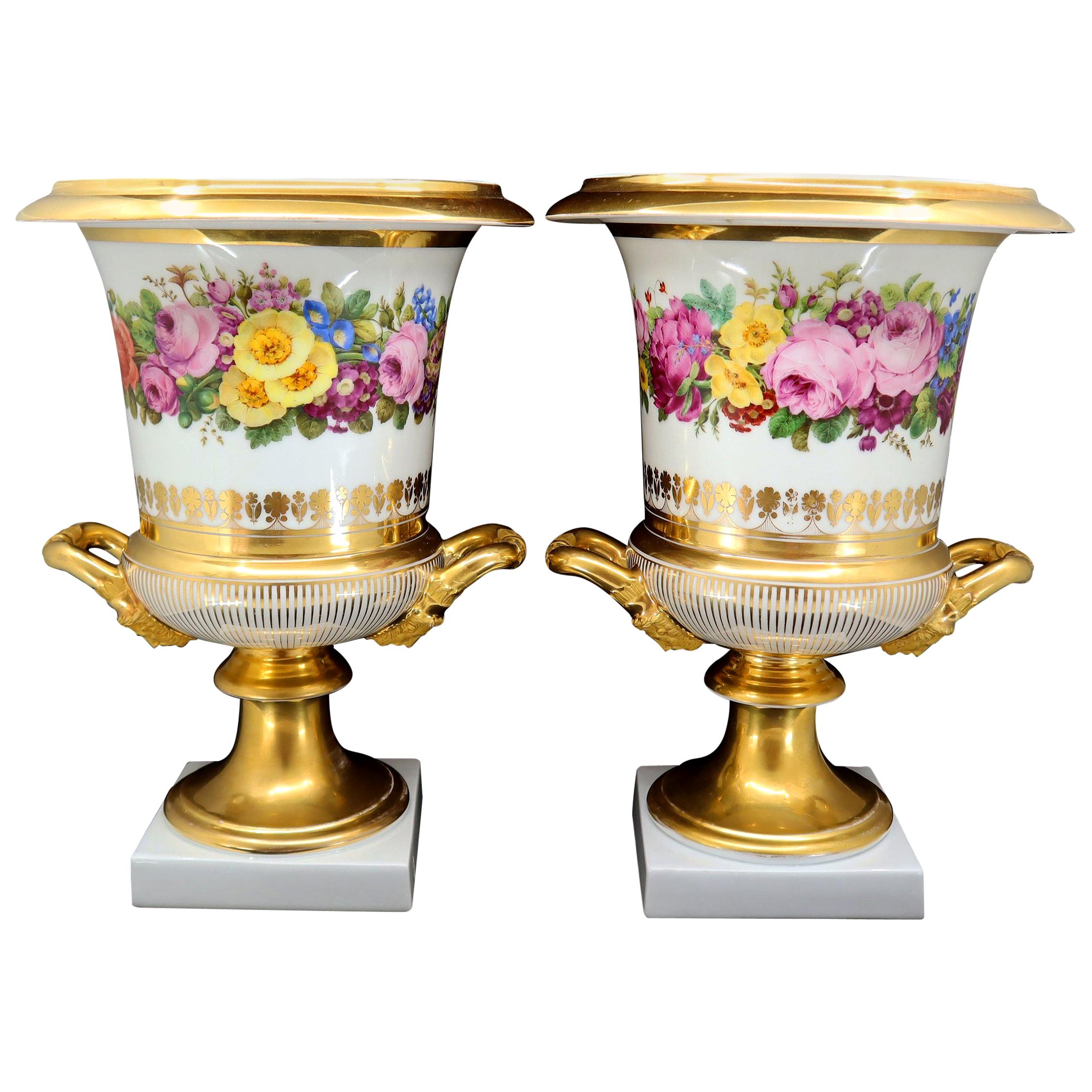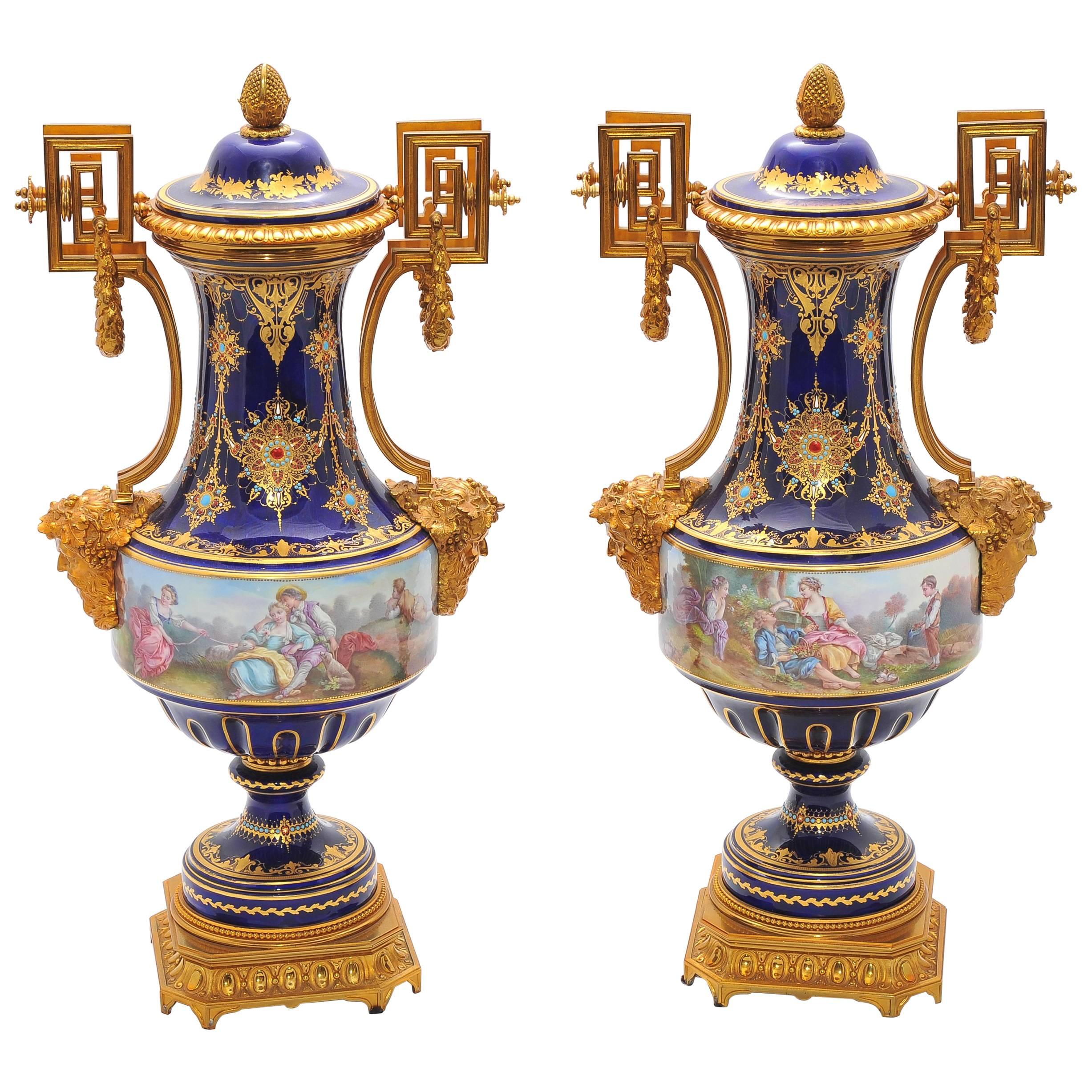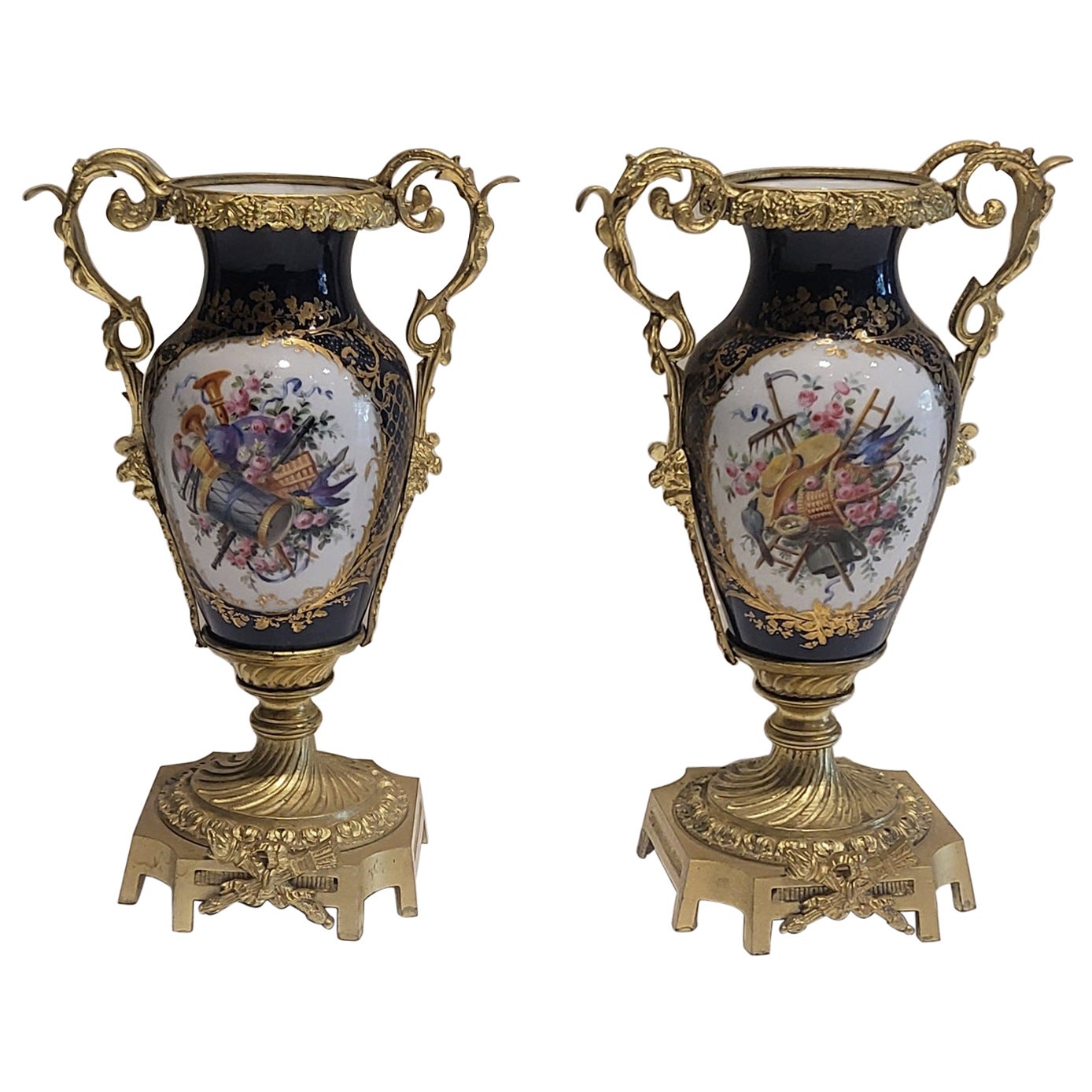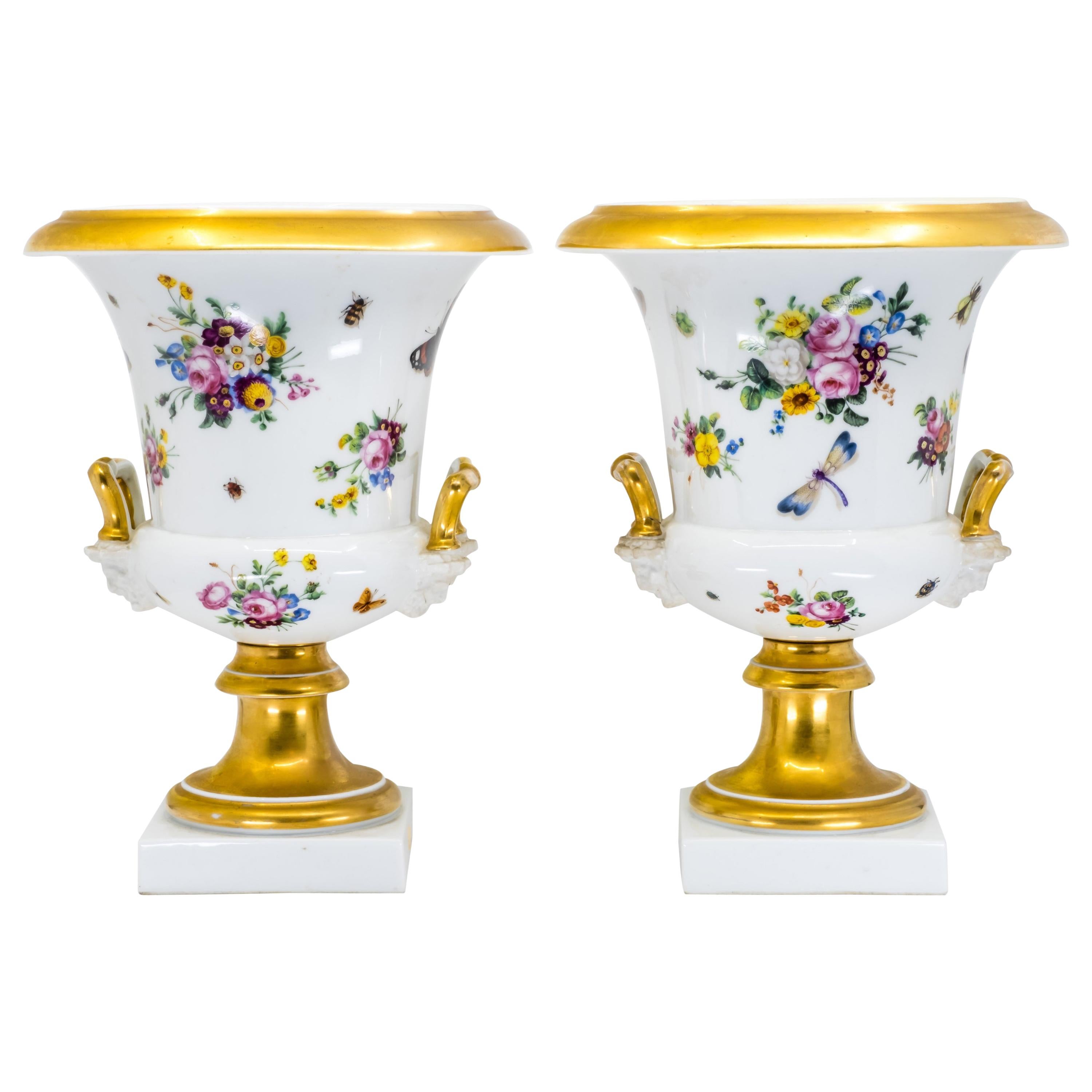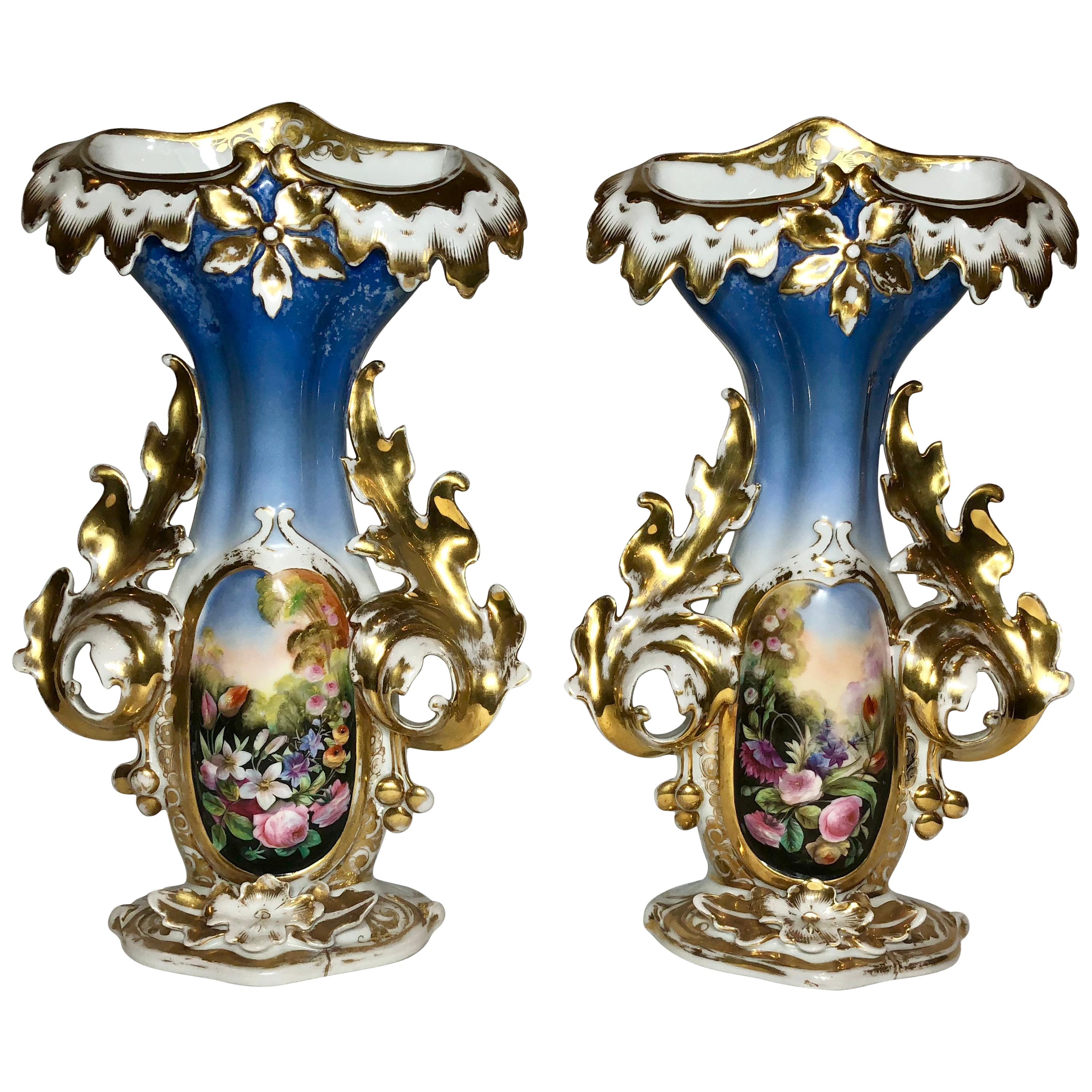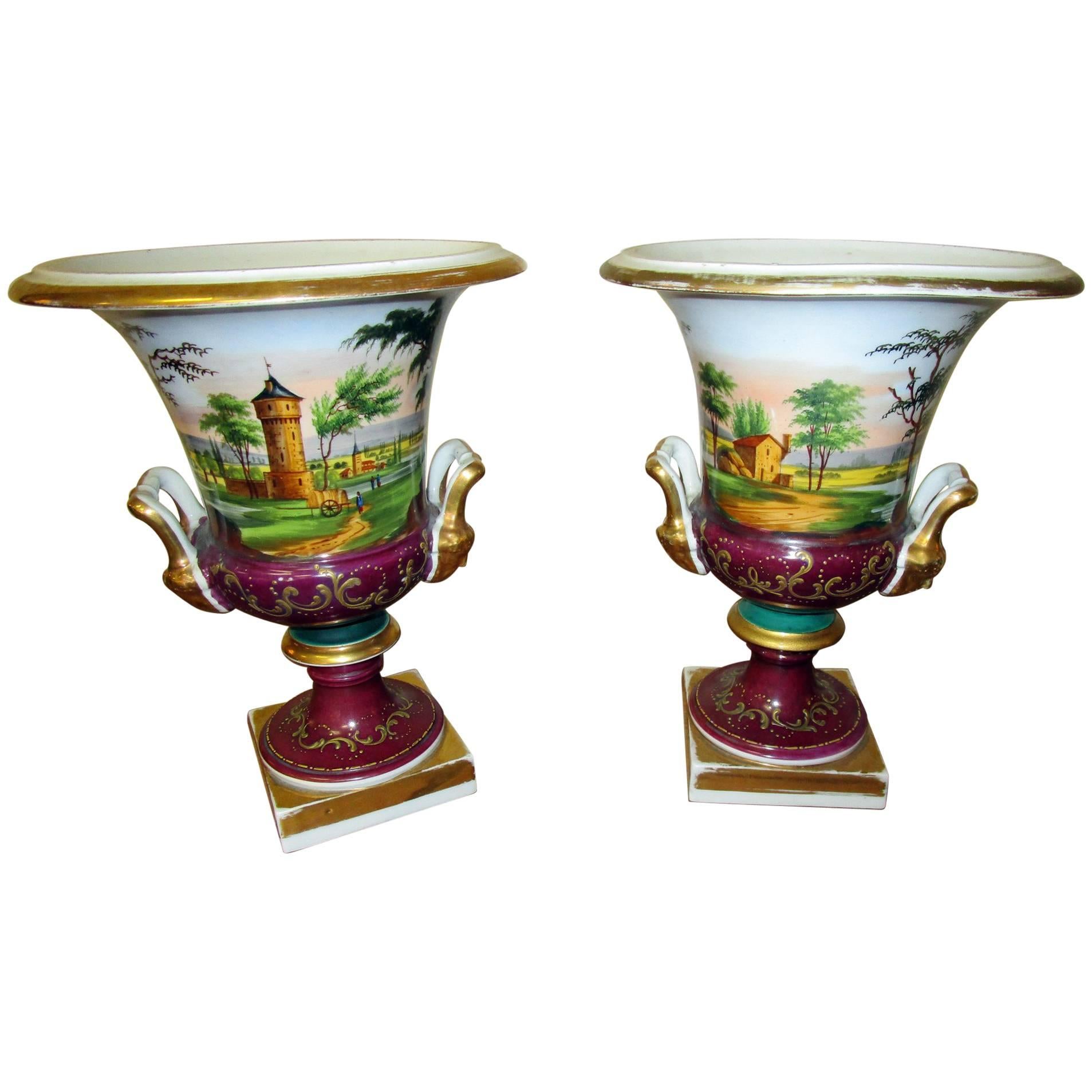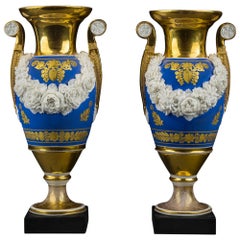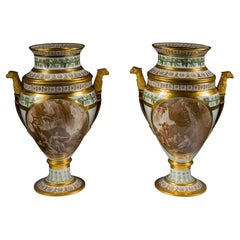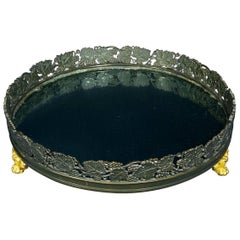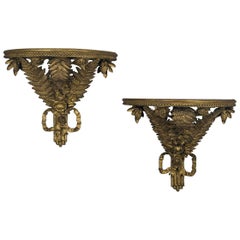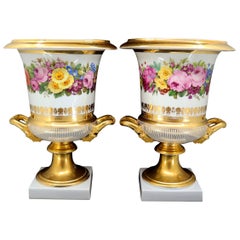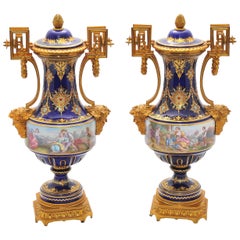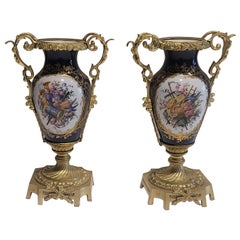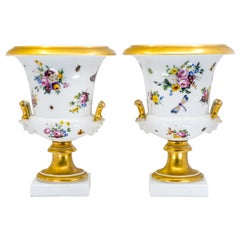Items Similar to Pair of Medici-Form Vases
Want more images or videos?
Request additional images or videos from the seller
1 of 6
Pair of Medici-Form Vases
$25,000per set
£18,891.01per set
€21,864.75per set
CA$35,073.77per set
A$39,012.09per set
CHF 20,465.69per set
MX$476,036.17per set
NOK 256,870.25per set
SEK 242,069.05per set
DKK 163,211.07per set
About the Item
Attributed to Schoelcher, Paris, France, circa 1830.
Porcelain, painted and gilded.
16 1/4 in. high, 9 1/2 in. wide, 9 1/2 in. deep.
Ex Coll.: by repute, Joseph Bonaparte, “Point Breeze,” Bordentown, New Jersey; Mrs. Harry Horton Benkard, Oyster Bay, New York; to her daughter, Bertha Bankard (Mrs. Reginald) Rose, and by descent, until 1992; to [Hirschl & Adler Galleries, New York, 1992–1993]; to private collection, New York, 1993–1995; to [Hirschl & Adler Galleries, New York, 1995–1996]; to private collection and by descent, until 2013.
This monumental pair of Medici-form vases is an extraordinary example of “Old Paris” porcelain made in Paris in the prevailing neoclassical style, circa 1830.
The attribution of this pair of vases to Schoelcher is based upon a marked pot de crème, which is part of a matching dinner service with the same provenance.
The firm of Schoelcher was one of the principal manufacturers/retailers of “Old Paris” porcelain. According to Regine de Plinval de Guillebon, Porcelain of Paris, 1770–1850 (New York: Walker and Company, 1972), Schoelcher apparently produced porcelain in the Faubourg Saint-Denis until sometime between 1810 and 1823. Later, from at least December 31, 1828, on, Marc Schoelcher and his son Victor sold porcelain from a shop at 2, Boulevard des Italiens, where they formed the company Schoelcher et Fils “for trading with wholesale and retail porcelain merchants in the salesroom of M. Marc Schoelcher.” The firm apparently lasted until January 1, 1835 (although Marc died in October 1832). De Guillebon illustrates a covered broth bowl and stand in the same “Rose-Wreath” design as the present vases, which bears the mark of Schoelcher, and which de Guillebon dates to, circa 1820.
A second dinner service with an identical pattern (see Stuart P. Feld, Neo-Classicism in America: Inspiration and Innovation, 1810–1840, exhib. cat. [Hirschl & Adler Galleries, New York, 1991, p. 125 no. 94, illus in color a covered soup tureen and platter) is documented as having been acquired in 1833 by George Hyde Clarke (1768–1835) of “Hyde Hall,” Cooperstown, Otsego County, New York, from the New York retailer Baldwin Gardiner, who had an extensive “Furnishing Warehouse” at 149 Broadway.
This pair of vases is said to have belonged to Joseph Bonaparte, brother of Napoleon, who lived at “Point Breeze,” Bordentown, New Jersey. They were acquired in New Jersey by the noted collector of Americana, Mrs. Harry Horton Benkard of Oyster Bay, Long Island, New York, and then descended to her daughter, Bertha Benkard (Mrs. Reginald) Rose, also a noted collector of American decorative arts.
Condition: Covers and liners probably missing, otherwise, perfect.
- Dimensions:Height: 16 in (40.64 cm)Width: 9.5 in (24.13 cm)Depth: 9.5 in (24.13 cm)
- Sold As:Set of 2
- Style:Empire (Of the Period)
- Materials and Techniques:
- Place of Origin:
- Period:
- Date of Manufacture:circa 1830
- Condition:Wear consistent with age and use. Condition: Covers and liners probably missing, otherwise, perfect.
- Seller Location:New York, NY
- Reference Number:Seller: FAPG 20510D/21stDibs: LU90322218542
About the Seller
No Reviews Yet
Recognized Seller
These prestigious sellers are industry leaders and represent the highest echelon for item quality and design.
Established in 1952
1stDibs seller since 2010
Associations
Art Dealers Association of America
- ShippingRetrieving quote...Shipping from: New York, NY
- Return Policy
Authenticity Guarantee
In the unlikely event there’s an issue with an item’s authenticity, contact us within 1 year for a full refund. DetailsMoney-Back Guarantee
If your item is not as described, is damaged in transit, or does not arrive, contact us within 7 days for a full refund. Details24-Hour Cancellation
You have a 24-hour grace period in which to reconsider your purchase, with no questions asked.Vetted Professional Sellers
Our world-class sellers must adhere to strict standards for service and quality, maintaining the integrity of our listings.Price-Match Guarantee
If you find that a seller listed the same item for a lower price elsewhere, we’ll match it.Trusted Global Delivery
Our best-in-class carrier network provides specialized shipping options worldwide, including custom delivery.More From This Seller
View AllPair of "Old Paris" Vases with Garlands of Bisquit Flowers
Located in New York, NY
French, circa 1820.
Porcelain, painted and gilded, with applied bisquit flowers
8 13/16 in. high.
Inscribed (with incised mark, under the base of each): 3.
Category
Antique 1820s French Neoclassical Porcelain
Materials
Porcelain
Pair of Porcelain Urn Form Fruit Coolers with Covers and Liners
By Stône, Coquerel, and Legros d'Anisy
Located in New York, NY
Pair Footed Fruit Coolers, about 1810-20
Stône, Coquerel, and Legros D’Anisy, Paris (active 1808–49)
Porcelain, partially transfer printed in sepia and green and gilded
Each, 13 1/2 in. high x 10 in. wide x 7 1/2 in. deep
Signed and inscribed (on underside of one top and one base, with printed mark): STÔNE /
COQUEREL / ET / LE GROS / PARIS / PAR BREVET D’INVENTION: Manufre de Décors sur
Porcelaine Faience; variously inscribed with decorators’ initial in green and brown (on
underside of one top and one base): M; variously inscribed with incised mark (on underside of one liner and both bottoms): 3; inscribed (in blue script, on the inside of one liner): 615
The Parisian firm of Stône, Coquerel, and Legros d'Anisy is distinguished for the important role that it played in the introduction of transfer-printed decoration on fine china in France. Although the process had been known and used in Great Britain since the eighteenth century, it was, according to Régine de Plinval de Guillebon in her book, Porcelain of Paris 1770–1850 (New York: Walker and Company, 1972), not until 1802 that Potter, Blancheron, Constant, Neppel, Cadet de Vaux & Denuelle took out a patent in France for transfer-printing on earthenware, and it was only on February 26, 1808, that John Hurford Stône, his brother-in-law, Athanase Marie Martin Coquerel, and Francois Antoine Legros d'Anisy not only took out a patent for transfer-printing on china, but also established a Stône, Coquerel, and d'Anisy partnership for the manufacture of transfer-printed ceramics. Their address from 1808 until 1818 was at 9, rue de Cadran, Paris.
Prior to this, Stône and Coquerel had been partners at a creamware factory in Creil, France, and Legros d’Anisy had worked at the Sèvres factory, where he had apparently developed the transfer-printing technique for which his own firm became well known. “The process,” notes de Guillebon, was “based upon removing from the engraving a ‘pull’ made on a specially coated filter-paper, which was pressed onto the object to be decorated; this object itself was covered with a film. Firing took...
Category
Antique Early 19th Century French Neoclassical Wine Coolers
Materials
Porcelain
Plateau in the Restauration Taste with Grape and Leaf Motifs
Located in New York, NY
French.
Plateau in the Restauration taste with grape and leaf motifs, circa 1825.
Ormolu and patinated bronze, with mirror plate and wood backing.
Measures: 15 7/8 in. diameter, 3 11...
Category
Antique 1820s French Neoclassical Platters and Serveware
Materials
Bronze
Pair of Fern Wall Brackets
Located in New York, NY
American, circa 1850-1880.
Eastern white pine (Pinus strobus), with wire armature and composition ornament, gessoed
and gilded.
Measures: 14 1/8 in. high, 16 5/16 in. wide (at the sh...
Category
Antique 19th Century American Aesthetic Movement Wall Brackets
Materials
Wood
$55,000 / set
Pair Side Chairs with Lyre Back
Located in New York, NY
“I know of no other chair like the single [sic] ‘lyre back’ one. . . . I certainly recognize it as a Boston chair considering all the individual elements, but the combination is particularly elegant.” So wrote noted scholar of Boston furniture Page Talbott when a set of four chairs of this design originally surfaced in the 1980s. Although the existence of four chairs in a specific pattern might imply that the chairs were originally part of a larger set, no additional chairs of this form have appeared in the intervening years.
The lyre became a popular motif during the Neo-Classical period, and is frequently encountered as the back splat of klismos chairs, in no example more familiar than in a group of Duncan Phyfe chairs...
Category
Antique 1820s American Neoclassical Chairs
Materials
Mahogany
$30,000 / set
Monumental Clear Cut-Glass Covered Compote
Located in New York, NY
Monumental clear cut-glass covered compote, circa 1820.
La Cristallerie de Vonêche (active 1802-30), Belgium.
Glass, blown and cut.
Measures: 17 3/8 i...
Category
Antique Early 19th Century Belgian Neoclassical Tableware
Materials
Blown Glass, Cut Glass
You May Also Like
Pair of 19th Century Medici Vases, Hand-Painted Porcelain
Located in Lantau, HK
A set of two crater vases from the second quarter of 19th century, century 1825-1830,
made of porcelain of France, crafted in the factory of Mortelèque in Ixelles (near Brussels),
Belgium and painted by the artist Frédéric Faber (1782-1844).
The model of the crater vase is based on the famed Medici crater in the Uffizi in Florence.
This type of vase was often reserved for lavish gifts among the aristocracy and royal courts
in Europe.
At the Salon of 1815, Faber’s work attracted king William I of the Netherlands
(1772-1843) who eventually named him the court’s official porcelain painter.
Another very similar pair of Medici vases...
Category
Antique Mid-19th Century French Vases
Materials
Porcelain
Pair of Antique Sèvres Vases
By Manufacture Nationale de Sèvres
Located in Brighton, Sussex
A very fine quality pair of French ormolu-mounted jewelled Sèvres porcelain lidded vases. Having classical romantic scenes and landscapes set between the cobalt blue, the gilded ormo...
Category
Antique 19th Century French Porcelain
Materials
Ormolu
$34,421 / set
Pair of Porcelain Vases
Located in Dallas, TX
A pair of ormolu mounted serves porcelain vases.
Category
Antique Early 1900s European American Classical Vases
Materials
Porcelain
$3,360 Sale Price / set
20% Off
Pair of Medici Vases, Hand Painted Porcelain, French, 19th Century
Located in Lantau, HK
A pair of elegant vases finely painted with flowers and butterflies in brilliant colors, richly gilded on handles and base.
Shipping included
Free and fast delivery door to door ...
Category
Antique 19th Century French Classical Roman Vases
Materials
Porcelain
Pair of Antique Mid-19th Century Old Paris Vases
Located in New Orleans, LA
Pair of antique mid-19th century Old Paris vases. From a Louisiana estate. These are beautiful and boast unusual, strong colors.
Category
Antique Mid-19th Century French Porcelain
Materials
Porcelain
$2,500 / set
Pair of Vieux Paris Campagna Form Urns
By Old Paris
Located in Savannah, GA
Hard paste porcelain with polychrome and gold leaf - iron bolt. Impasto decoration. Lovely colors. These classical form urns are clearly a pair, but not an identical pair. Each has a...
Category
Antique 1820s French Empire Urns
Materials
Porcelain
$550 Sale Price / set
75% Off
More Ways To Browse
Empire Furniture Company Antique
Antique Rose Glass Vase
Porcelain Covered Bowl
Mid Century Glass Cat
Antique Glass Rose Bowl
Porcelain Bears
Walker And Hall Silver
Pair Of Tureens
Walker And Hall Antique Silver
French Soup Bowl
P M Porcelain
Rose Tureen
Mark Horton
Oyster Bowl
Porcelain Cats
Paris Porcelain Dinner Service
Paris Porcelain Tureen
George Coll
